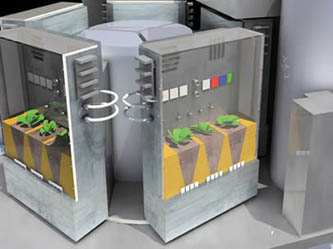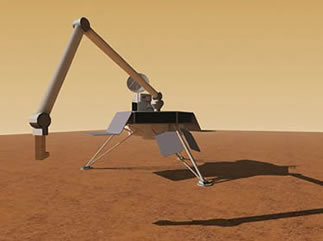|
|
UF Architects Help Design Mars Greenhousedownloadable pdfForget domed cities and gardens under glass. When the first Earth organisms land on the surface of Mars, they’ll live in a metal box the size and shape of a toaster, under the glare of artificial lights. That’s the vision University of Florida researchers have developed for an experiment that could take a handful of plants to the Red Planet aboard a future space probe.
“When you think of greenhouses on Mars, this metal box is not the first thing that comes to mind, but it gets the job done,” said UF professor of architecture John Maze. Maze and UF architecture graduate students Jason Matthews and Andrew Willard were tapped by UF’s Space Agriculture and Biotech Research and Education Center — also known as SABRE — to draft models of a device they hope to send to the Red Planet on a future robotic Mars mission. The experiment would take roughly a dozen seeds of the Arabidopsis plant, a small weed commonly used in scientific experiments, to the Martian surface, where they would be planted in soil dug up from the planet’s surface. Each plant would be genetically engineered to produce a glow in the presence of a specific mineral or set of nutrients, giving researchers a glimpse into the makeup of the Martian surface and its effect on living things. “Electronic methods like spectroscopy can tell us, and have told us, a lot about the composition of Martian soil,” said Rob Ferl, a professor of molecular biology at UF’s Institute of Food and Agricultural Sciences and director of SABRE. “But they can’t tell us whether certain minerals are present in the soil in a way that makes them available for uptake by plants. The only way to know for sure is to grow plants in the soil.” The result of such an experiment could change the shape of future human exploration of Mars, Ferl said. To live on the planet, he said, people would have to be able to use local resources to meet their daily needs, including using Martian soil to grow food. Ferl’s experiment was designed to be placed on a robotic Mars lander. The schedule for future human missions is currently in development, as NASA considers new mission plans to explore the Moon, Mars and beyond.
“There’s a great deal of fundamental biological research that has to be done before a human mission to Mars can happen,” Ferl said. “I think a lot of biological experiments like this one are on the near horizon.” Getting an experiment on a spacecraft isn’t easy. Landers are typically small, reflecting the high cost of sending equipment into space, and hundreds of proposed experiments compete for a place on every craft. To help convince the decision-makers at NASA to include his experiment on a future rover, Ferl needed a model that would show them how the experiment would work, and how much space it would fill. The experiment didn’t simply need to be small — it needed to be simple. When a device breaks on a probe in deep space, there’s no one there to fix it, so NASA scientists try to build probes with as few moving parts as possible. The current design is a far departure from the glass-domed space greenhouses of science fiction. From the outside, the growth chamber would look like a featureless metal box with a slot in the top. Martian soil could be fed into the slot by a robot arm of the sort expected to be included on future Mars landers. Inside the box, plants would grow in one of a dozen “pots” mounted on a rotating cylinder. The cylinder would turn to bring each pot to stations where they could be filled with soil, planted with seeds, or watered when needed. The growth of each plant would be monitored by cameras that would relay their images back to Earth. Out-of-this-world projects are an everyday experience for Maze, who uses high-tech design software — often the same software used by Hollywood animators — to take architecture far beyond the mere design of buildings. In a recent project, Maze explored the shape of cyberspace, creating a model that showed what the Internet would look like if it were a physical structure. He and his graduate students are now fleshing out the architecture of music — designing structures that visually echo the cadences, tonality and other qualities of famous musical compositions. “If you could see the Brandenburg Concertos, what would they look like?” asked Maze. “It’s not as far-fetched as it sounds. Obviously, there is structure within music, and there’s even structure that has a visible element — simply put, like a piano composition that is played only on black keys. This type of logic or order is what is fundamental to both music and architecture.” Maze said he jumped at the chance to design a device potentially bound for Mars, though he knew the end result would challenge standard architectural aesthetics. “I was fascinated with the space program when I was younger, like any red-blooded American kid,” he said. “There’s no way I would pass up a chance like this.” He said a long-term human presence on the Moon or Mars could present architects and designers with interesting challenges in the future. Architects could be called on to create structures that help people live more comfortably in cramped environments with little or no gravity, he said. “As people spend more time in space, I think the human element will become more important in these designs,” he said. John Maze, maze@ufl.edu Tim Lockette
|


